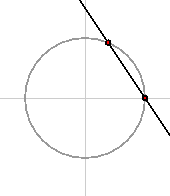 How can we find all Pythagorean triples?
How can we find all Pythagorean triples?
If a, b, and c are all positive integers, this is called a Pythagorean triple. The best known example, and the simplest one, is 3, 4, 5 since
and another well known one is 5, 12, 13.
 How can we find all Pythagorean triples?
How can we find all Pythagorean triples?
If a, b, c is a Pythagorean triple, then so is ma, mb, mc for any positive integer m. Thus in order to find all of them, it suffices to find those which are primitive - i.e. for which there does not exist a common divisor of all three coordinates.
Because if a prime number p divides two of them, say a and b, it will also divide c2, hence c.
If a and b are both even, then a2+b2 will be even as well, and they cannot be part of a primitive Pythagorean triple. If a and b are both odd, then a2+b2 will be congruent to 2 modulo 4, and it cannot be the square of an integer. Therefore in a primitive Pythagorean triple exactly one of a and b is odd and one even.
If (a, b, c) is a primitive Pythagorean triple, then the point (a/c, b/c) is a point on the unit circle with rational coordinates expressed as reduced fractions. In fact, finding all Pythagorean triples turns out to be nearly equivalent to finding all such points.
 How can we find all points
(A, B) on the unit circle with rational coordinates?
How can we find all points
(A, B) on the unit circle with rational coordinates?
If (A, B) is a rational point on the unit circle other than (1,0), then the line through (A,B) and (1,0) has the equation
whose slope is the rational number m = B/(A-1). Conversely, if m is any rational number then the line through (1,0) with slope m intersects the unit circle at one other point. Thus there is exactly one rational point on the unit circle for each rational slope. Those with positive coordinates correspond to slopes m less than -1.

and if exactly one of p, q is even and one odd then the triple
will be a primitive Pythagorean triple. Conversely, suppose that a, b, c be a primitive Pythagorean triple. One of a, b is even - say b = 2n. Then
Since c and a are relatively prime, so are the factors (c-a)/2 and (c+a)/2, so that each of these is also a square. Set
Written by Bill Casselman.